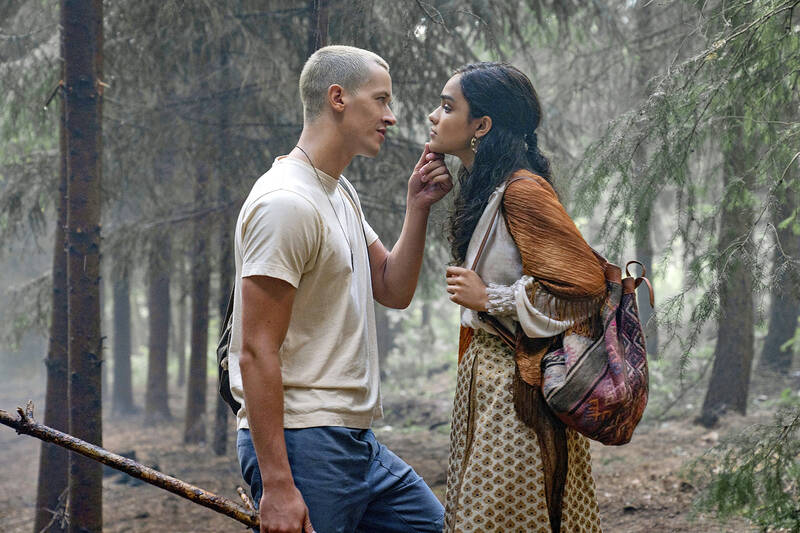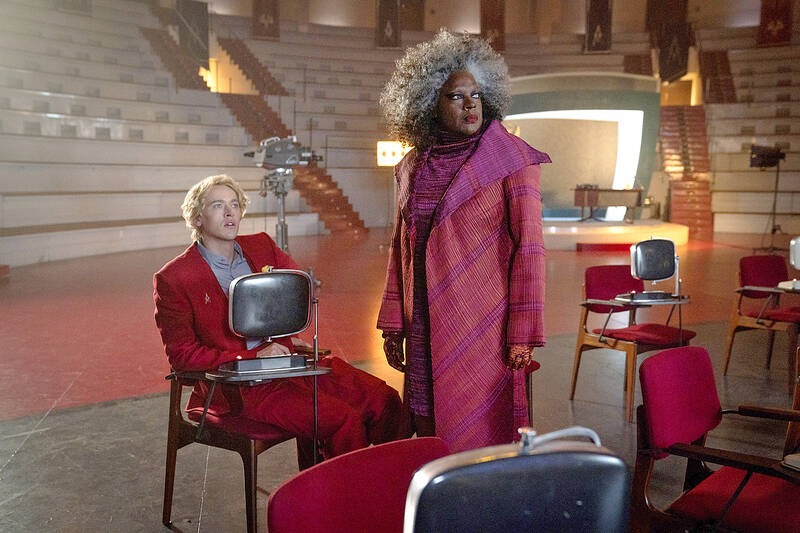Everyone had resigned themselves to the fact that The Hunger Games ended in 2015. The four-film blockbuster franchise had made nearly US$3 billion at the global box office and helped Jennifer Lawrence skyrocket to superstardom. But Suzanne Collins’ Katniss Everdeen saga was over. And, frankly, everyone, including Collins, director Francis Lawrence and producer Nina Jacobson, was eager to take a break and do something else.
For several years after Mockingjay — Part 2, Hunger Games-related text conversations between Lawrence and Collins rarely went past sending one another screenshots of their films on Jeopardy categories. Then, in 2019, Jacobson and Lawrence got a call: Collins was putting the finishing touches on something new, a prequel set 64-years before Katniss volunteered as tribute. It would be focused on a young Coriolanus Snow, and there would be a big musical element.
The Hunger Games: The Ballad of Songbirds & Snakes arrives in Taiwan’s theaters nationwide Friday at another transitional moment in Hollywood, where Marvel movies are no longer sure things and, for the first time in a long time, the biggest movies of the year aren’t already franchises.

Photo: AP
And while the team was excited about the possibility of working together again, there were some nerves about whether or not there was an appetite for Hunger Games movies “without Katniss,” Lawrence said. But this was all before they’d laid eyes on the book.
Both Lawrence and Jacobson were soon brought into Collins’ agent’s office, seated in a locked room and given the book to read. To their relief, suddenly the Katniss problem didn’t seem so important anymore, and soon they were off to Lionsgate to get it off the ground.
“We were excited to be able to dive into something that didn’t feel like a rehash,” Jacobson said. “It didn’t feel like we were trying to imitate the previous movies.”

Photo: AP
For Lawrence, it “felt like a Hunger Game story” but also something unique, “with new thematic foundations.”
“Instead of a girls’ survival story, it was a young man’s descent into darkness,” Lawrence said. “It’s an origin story about a major character and also the series itself.”
As with the first film, Lawrence and Jacobson wanted to find fresh young talents to lead the franchise — not a TikTok star or someone already famous in another part of the world — and surround them with veteran actors. In this case, those established names would include Viola Davis, Peter Dinklage and Jason Schwartzman.

Photo: AP
They found their young Snow, played in the original films by Donald Sutherland, via taped submission. The English actor Tom Blyth entered the running rather late and quickly became the frontrunner, beating out hundreds for the role.
“He just blew everybody out of the water,” Lawrence said. “He has a charisma, he has the right physical attributes. He’s Juilliard trained. He really knows his craft. He was going to be able to give us all the emotional values we need for the character’s journey. And he felt like a star.”
For Lucy Gray Baird, the District 12 tribute Snow is assigned to mentor for the 10th Hunger Games, Lawrence already had someone in mind. Like many film fans, he was transfixed by Rachel Zegler ’s film debut as Maria in Steven Spielberg’s West Side Story and persuaded her to co-star. It wasn’t a hard sell: The Hunger Games were already a big part of Zegler’s life having grown up with the books and the movies, which she and her mom and sister made events out of.
“As somebody who loves to call herself a fan first before anything else, the greatest gift you can get is more to the story,” Zegler said. “Rather than seeing it as a pressure cooker just waiting to explode, I see it as a really big blessing.”
Blyth, in his first starring role in Hollywood, felt some pressure. But he found comfort in the material they were working with.
“We’re lucky to be adapting a book that’s really good,” Blyth said. “Suzanne writes these big thinking pieces that are approachable for teenagers and younger people, which I think is a genuinely honorable feat — someone who wants to try and bring bigger ideas to young people while also entertaining them.”
Filming took place largely in Germany. The production looked to reconstruction-era Berlin for aesthetic and thematic inspiration for this post-war capitol that’s rebuilding and on tenuous political ground. And Trish Summerville was also brought back to design the ornate costumes, which include some Easter eggs for fans hidden in Lucy’s hand-painted corset.
“There’s this spectacle to the whole world,” Blyth said. “The whole thing is about spectacle. It’s about being distracted by beautiful things while everything else is going on.”
But even while creating a new world, the filmmakers were disciplined about the budget. Instead of resting on laurels and precedent — Mockingjay Part 2 had a US$160 million price tag — they kept theirs to a reported US$100 million.
“We were very mindful that this was not a sequel but a prequel with a new cast,” Jacobson said. “We wanted to make sure that we were making this movie at a price that that made sense.”
It’s easy to forget that not everyone in Hollywood thought that they had a blockbuster in their hands at the beginning. Back in 2009, when Jacobson and her production company ColorForce acquired the rights to adapt Collins’ YA series, there was widespread skepticism about young adult material and about the appeal of female-fronted action movies that weren’t primarily romances.
“In the original series, we were able to take a lot of risks and really challenge a lot of industry assumptions,” Jacobson said. “The most important thing in this go-around was to still take those risks and not be playing it safe — to still feel like we’re making something that’s a bit on the subversive side.”
With its moral ambiguity and complicated characters, Jacobson thinks it might even be the kind of movie that audiences want to discuss and debate afterward. In the past year, she added, a lot of young people have discovered the franchise on streaming who will hopefully join established fans at the theater for The Ballad of Songbirds & Snakes
“I’m hopeful that it will be a shared cultural experience and a communal experience at a time when we don’t have too many of those,” Jacobson said. “When they do happen, as they have this year with movies as different as Barbie and Oppenheimer it certainly shows that if you give people a worthwhile and original story with some bold storytelling and a filmmaker with a voice, that they will show up. And we hope to be part of that showing up.”

Taiwanese chip-making giant Taiwan Semiconductor Manufacturing Co (TSMC) plans to invest a whopping US$100 billion in the US, after US President Donald Trump threatened to slap tariffs on overseas-made chips. TSMC is the world’s biggest maker of the critical technology that has become the lifeblood of the global economy. This week’s announcement takes the total amount TSMC has pledged to invest in the US to US$165 billion, which the company says is the “largest single foreign direct investment in US history.” It follows Trump’s accusations that Taiwan stole the US chip industry and his threats to impose tariffs of up to 100 percent

On a hillside overlooking Taichung are the remains of a village that never was. Half-formed houses abandoned by investors are slowly succumbing to the elements. Empty, save for the occasional explorer. Taiwan is full of these places. Factories, malls, hospitals, amusement parks, breweries, housing — all facing an unplanned but inevitable obsolescence. Urbex, short for urban exploration, is the practice of exploring and often photographing abandoned and derelict buildings. Many urban explorers choose not to disclose the locations of the sites, as a way of preserving the structures and preventing vandalism or looting. For artist and professor at NTNU and Taipei

March 10 to March 16 Although it failed to become popular, March of the Black Cats (烏貓進行曲) was the first Taiwanese record to have “pop song” printed on the label. Released in March 1929 under Eagle Records, a subsidiary of the Japanese-owned Columbia Records, the Hoklo (commonly known as Taiwanese) lyrics followed the traditional seven characters per verse of Taiwanese opera, but the instrumentation was Western, performed by Eagle’s in-house orchestra. The singer was entertainer Chiu-chan (秋蟾). In fact, a cover of a Xiamen folk song by Chiu-chan released around the same time, Plum Widow Missing Her Husband (雪梅思君), enjoyed more

From insomniacs to party-goers, doting couples, tired paramedics and Johannesburg’s golden youth, The Pantry, a petrol station doubling as a gourmet deli, has become unmissable on the nightlife scene of South Africa’s biggest city. Open 24 hours a day, the establishment which opened three years ago is a haven for revelers looking for a midnight snack to sober up after the bars and nightclubs close at 2am or 5am. “Believe me, we see it all here,” sighs a cashier. Before the curtains open on Johannesburg’s infamous party scene, the evening gets off to a gentle start. On a Friday at around 6pm,